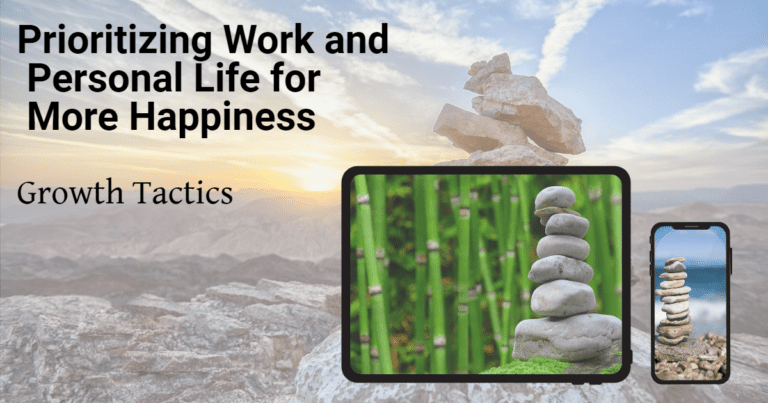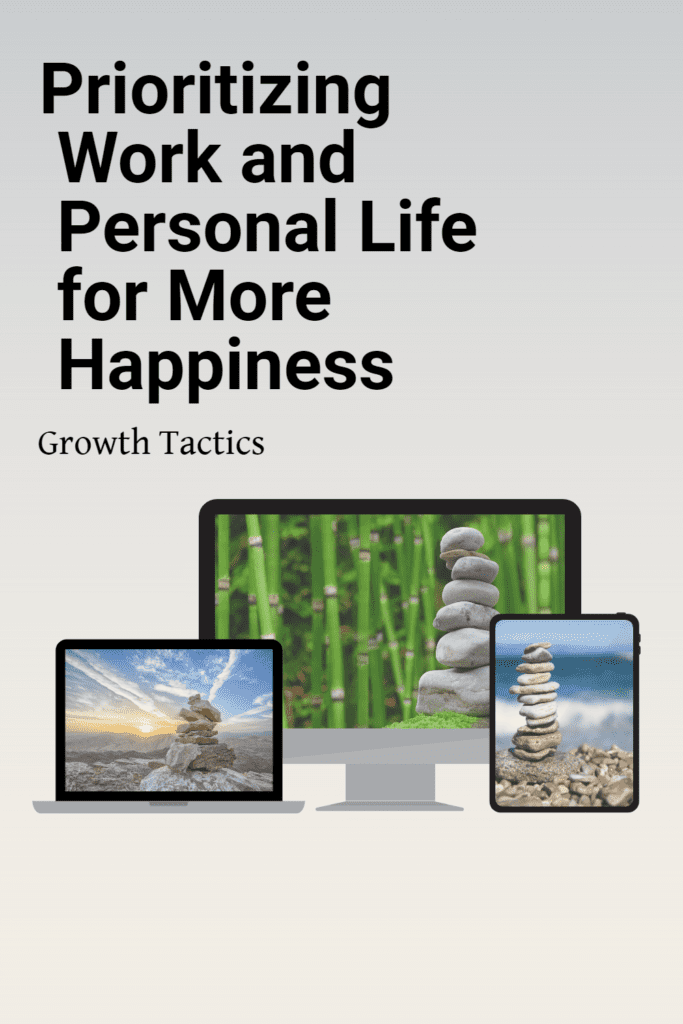Prioritizing work and personal life is essential for overall well-being and long-term success. It allows you to prioritize your personal life while still being productive at work, avoiding burnout, and maintaining a healthy physical and mental state. In this article, we will explore different ways to prioritize and improve work-life balance, and the importance of achieving a healthy balance between work and life.
Jump To Section
Understanding Work-Life Balance
Work-life balance refers to the equilibrium between your professional and personal life. It is about allocating time and energy to the different areas of your life in a way that is aligned with your goals and values. Many people struggle with achieving a good work-life balance, leading to negative consequences on their overall well-being.

Setting Life Priorities
To achieve a healthy work-life balance, it’s crucial to set clear priorities in your life. Take a moment to reflect on what truly matters to you, both personally and professionally. By clarifying your values and goals, you can align your actions with what brings balance and fulfillment. Remember, it’s perfectly okay to say no to tasks or commitments that don’t align with your priorities.
Identify Your Values and Goals
Start by identifying your core values and long-term goals. This will help you understand what truly matters to you and what you want to achieve in different aspects of your life. Consider your personal relationships, health, career aspirations, and personal development. By having a clear vision of what you want to prioritize, you can make informed decisions that support your work-life balance.
Evaluate and Prioritize
Once you’ve identified your values and goals, it’s time to evaluate how you’re currently spending your time and energy. Take a critical look at your daily activities and responsibilities. Are they aligned with your priorities? Are there any areas of your life that are taking up more time than they should? Evaluate and reassess regularly to ensure you maintain a healthy balance.
Learn to Say No
One of the most important skills in achieving work-life balance is learning to say no. It can be challenging, but setting boundaries is essential for maintaining a healthy balance. Understand that by saying no to certain tasks or commitments, you are actually saying yes to your own well-being and happiness. Remember, you have the power to choose how you spend your time and energy.

Communicate Your Priorities
It’s crucial to communicate your priorities with your colleagues, friends, and family. Let them know what’s important to you and the boundaries you’ve set. Effective communication can help others understand and respect your need for work-life balance. Be open and honest about your priorities, and encourage open discussions about the importance of maintaining a healthy balance.
By setting clear priorities in your life, you can create a roadmap that guides your actions and decisions. It allows you to focus on what truly matters to you, leading to a more fulfilling and balanced life. Remember, it’s never too late to reassess and adjust your priorities as your circumstances and goals evolve.
Creating Boundaries
Creating boundaries is essential for maintaining a healthy work-life balance. It’s important to set clear guidelines for your working hours and personal time. By doing so, you can avoid overworking and burnout, and ensure that you have enough time to focus on your personal life and activities.
Set Clear Working Hours
Setting clear working hours is crucial, especially when you work from home or have a flexible work schedule. It’s important to communicate your working hours with your colleagues and superiors so they know when you are available. This way, you can avoid taking work-related calls or emails outside of your working hours, allowing for much-needed downtime.
Designate Personal Time
Just as it’s important to set clear working hours, it’s also important to schedule personal time. This allows you to prioritize your personal life and activities, such as spending time with family, pursuing hobbies, or simply relaxing. By designating specific times for personal activities, you can avoid feeling guilty or overwhelmed when taking time off work.
Disconnect from Work
In today’s digital age, it can be challenging to disconnect from work. However, it’s essential to do so to maintain a healthy work-life balance. Create a routine that allows you to disconnect from work outside of your working hours. For example, you could turn off your work phone or laptop, or set up an automatic email responder. By doing this, you can focus on your personal life and recharge for the next workday.
Communicate Your Boundaries
It’s crucial to communicate your boundaries with your colleagues and superiors. Let them know what your working hours are and what times you’re available for work-related questions or tasks. Be clear about your personal time and the importance of maintaining a healthy work-life balance. Effective communication can foster understanding and mutual respect for each other’s priorities.
Creating and maintaining boundaries can be challenging, but it’s the key to maintaining a healthy work-life balance. By setting clear guidelines for your working hours and personal time, and communicating your boundaries with others, you can enjoy both personal and professional success without sacrificing your well-being.

Working Remotely and Work-Life Integration
With the rise of remote work, finding the right balance between work and personal life has become even more challenging. When working from home, it is important to establish a dedicated workspace and set a schedule to separate your work and personal life. Incorporate personal activities into your routine and make time to recharge and take care of yourself.
Improving Productivity
Improving your productivity can contribute to a better work-life balance. Start your day by identifying your top priorities and focusing on completing those tasks first. Use time management techniques such as the Pomodoro Technique or time-blocking to better manage your work hours. By being more productive, you can accomplish more in less time, allowing for more personal time outside of work.
When it comes to improving productivity, there are various strategies and techniques you can implement to make the most of your work hours. Here are some additional tips to help you enhance your productivity and achieve a better work-life balance.
- Set Clear Goals: Start your day by setting clear goals and priorities. Identify the most important tasks that need to be accomplished and focus on those first. This will help you stay organized and eliminate distractions.
- Use Time management techniques: Time management techniques like the Pomodoro Technique can be highly effective in improving productivity. It involves working for a set amount of time, typically 25 minutes, and then taking a short break. This helps you maintain focus and avoid burnout. Another technique is time-blocking, which involves allocating specific blocks of time for different tasks or activities.
- Minimize Distractions: Identify and minimize any distractions that can hinder your productivity. This could include turning off notifications on your phone, closing unnecessary tabs on your computer, or finding a quiet space to work where you won’t be easily disrupted.
- Prioritize Deep Work: Deep work refers to uninterrupted and focused work on tasks that require concentration and cognitive effort. Dedicate specific blocks of time for deep work, where you can fully immerse yourself in the task at hand without any distractions.
- Delegate and Collaborate: Don’t be afraid to delegate tasks that can be handled by others. Prioritize your own workload and team up with colleagues to share responsibilities when possible. Collaboration and effective delegation can help lighten your workload and free up time for other important activities.
- Take Breaks: It may seem counterintuitive, but taking regular breaks actually boosts productivity. Allow yourself time to rest and recharge, whether it’s a short walk, a brief meditation session, or simply stepping away from your workspace for a few minutes. Breaks help prevent burnout and enable you to come back to your tasks feeling refreshed and focused.
- Maintain a Healthy Work-Life Balance: Improving productivity shouldn’t come at the expense of your work-life balance. It’s crucial to set boundaries, establish clear working hours, and designate personal time for activities that bring you joy and relaxation. Remember that a healthy balance between work and personal life contributes to overall productivity and well-being.
By implementing these strategies, you can effectively improve your productivity and create a better work-life balance. Remember that finding the right combination of techniques may require some experimentation. Be flexible in adapting your approach until you find what works best for you.
Taking Care of Your Physical and Mental Health
Your physical and mental health should always take precedence. Incorporate exercise, healthy eating, and regular breaks into your routine to maintain a physically healthy lifestyle. Additionally, practice mindfulness and stress-reducing techniques to support your mental well-being. By prioritizing self-care, you will be better equipped to handle the demands of work and maintain a healthy work-life balance.
Finding Support
Achieving and maintaining a healthy work-life balance is a journey, and having a support system in place can make a world of difference. Here are some tips on finding the right support to help you along the way.
Seek Like-minded Individuals
Surround yourself with people who understand and value the importance of work-life balance. Seek out colleagues or friends who are on a similar journey of finding balance in their own lives. They can provide empathy, understanding, and practical advice based on their own experiences.
Connect with Mentors
Find mentors who have successfully navigated the challenges of work-life balance. These could be individuals within your organization or industry who have achieved a healthy balance between their personal and professional lives. Engage in conversations with them and learn from their strategies and insights.
Consider Professional Coaches
Professional coaches can be invaluable in helping you achieve work-life balance. They provide support, guidance, and accountability. A coach can help you identify your priorities, set realistic goals, and develop strategies to overcome obstacles along the way.
Seek Advice and Guidance
Don’t be afraid to reach out for advice and guidance. When faced with challenges or difficult decisions, consult your support system. Ask for their input, perspective, and suggestions. This collective wisdom can provide clarity and help you make informed choices.
Engage in Networking and Communities
Join networking groups or online communities focused on work-life balance. These platforms provide a space to connect with others who share similar goals and challenges. Engaging in discussions, sharing experiences, and learning from others can be incredibly valuable in your journey towards work-life balance.
Be Open to Learning
Approach finding support with an open mind and a willingness to learn. Be receptive to new ideas and perspectives. Remember that everyone’s journey and approach to work-life balance may be different. By being open to different viewpoints, you can gain valuable insights that may work for you.
Finding support is crucial in maintaining a healthy work-life balance. Seek out like-minded individuals, connect with mentors and coaches, and engage in networking and communities. Remember to be open to learning and willing to seek advice and guidance along the way. Together, you can navigate the challenges and find the balance that works best for you.
Summary
- Prioritizing work-life balance is essential for overall well-being and success.
- Set life priorities and boundaries to maintain a healthy work-life balance.
- Avoid the hustle culture and focus on working smartly and efficiently.
- Improving productivity and taking care of your physical and mental health are key.
- Find support from mentors, colleagues, and coaches to navigate the challenges.
Remember, achieving a good work-life balance requires effort and conscious decision-making. By implementing these strategies and prioritizing your personal life, you can lead a happier and healthier life both inside and outside of the workplace.


